HNB3123 Working with Evidence: Critical Analysis of Nursing Article
VerifiedAdded on 2023/06/12
|7
|1816
|455
Essay
AI Summary
This essay provides a critical analysis of a research article focusing on nurses' experiences and perspectives on medication safety practices. It assesses the article's introduction, research problem, methodology, findings, and conclusion. The analysis covers the study's design, including the use of case study approach and snowball sampling, and evaluates the relevance of the findings to contemporary nursing policy and practice. The essay highlights the role of nurses in medication safety, emphasizing the importance of safe preparation, administration, and clinical reasoning. It also discusses the significance of awareness, circumstances, and safety practices in reducing medical errors and improving patient outcomes. The critique concludes by emphasizing the implications of the study for the field of nursing and suggesting future research directions, particularly focusing on the roles of nurses and managers in creating patient safety practices. This resource is helpful for students who are looking for similar solved assignments and past papers on Desklib.
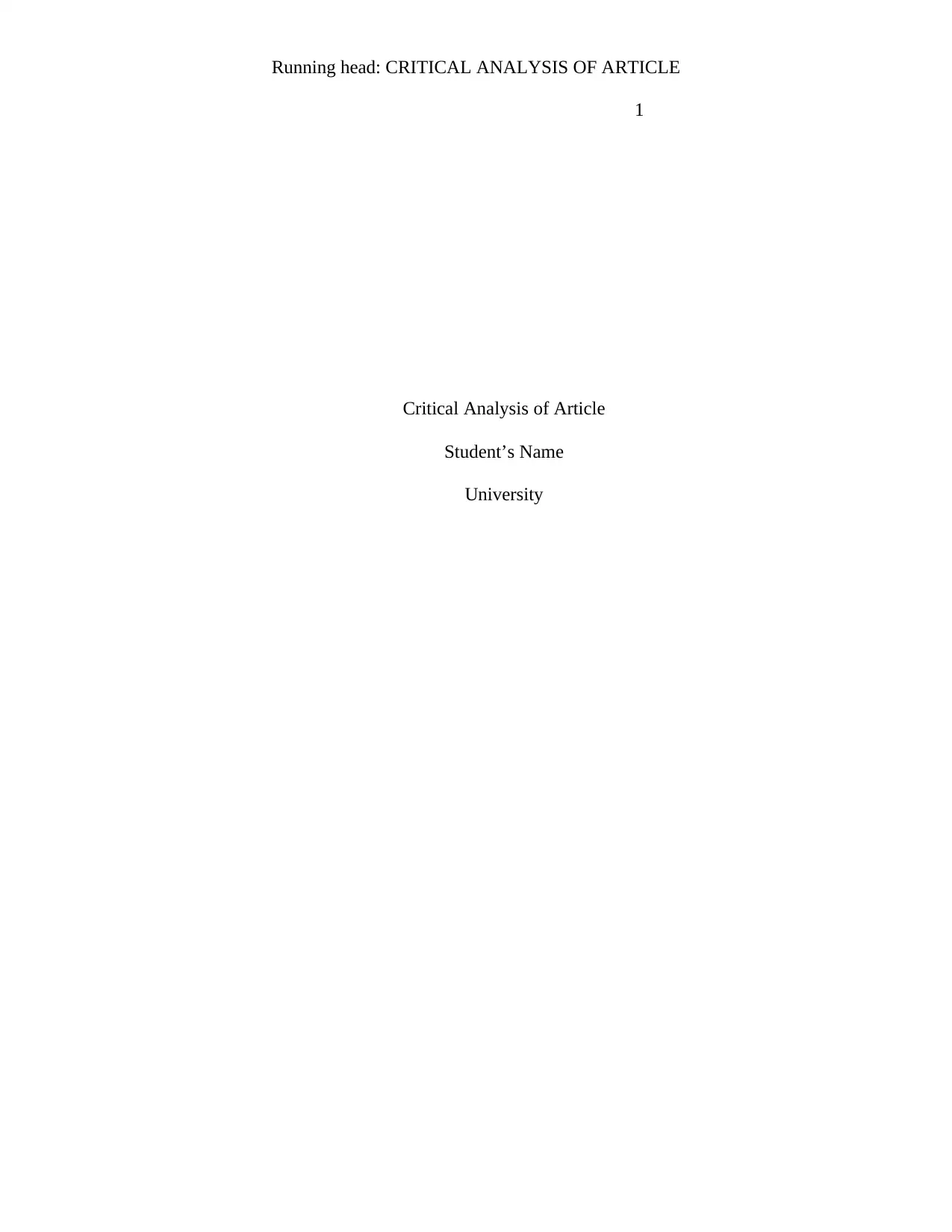
Running head: CRITICAL ANALYSIS OF ARTICLE
1
Critical Analysis of Article
Student’s Name
University
1
Critical Analysis of Article
Student’s Name
University
Paraphrase This Document
Need a fresh take? Get an instant paraphrase of this document with our AI Paraphraser
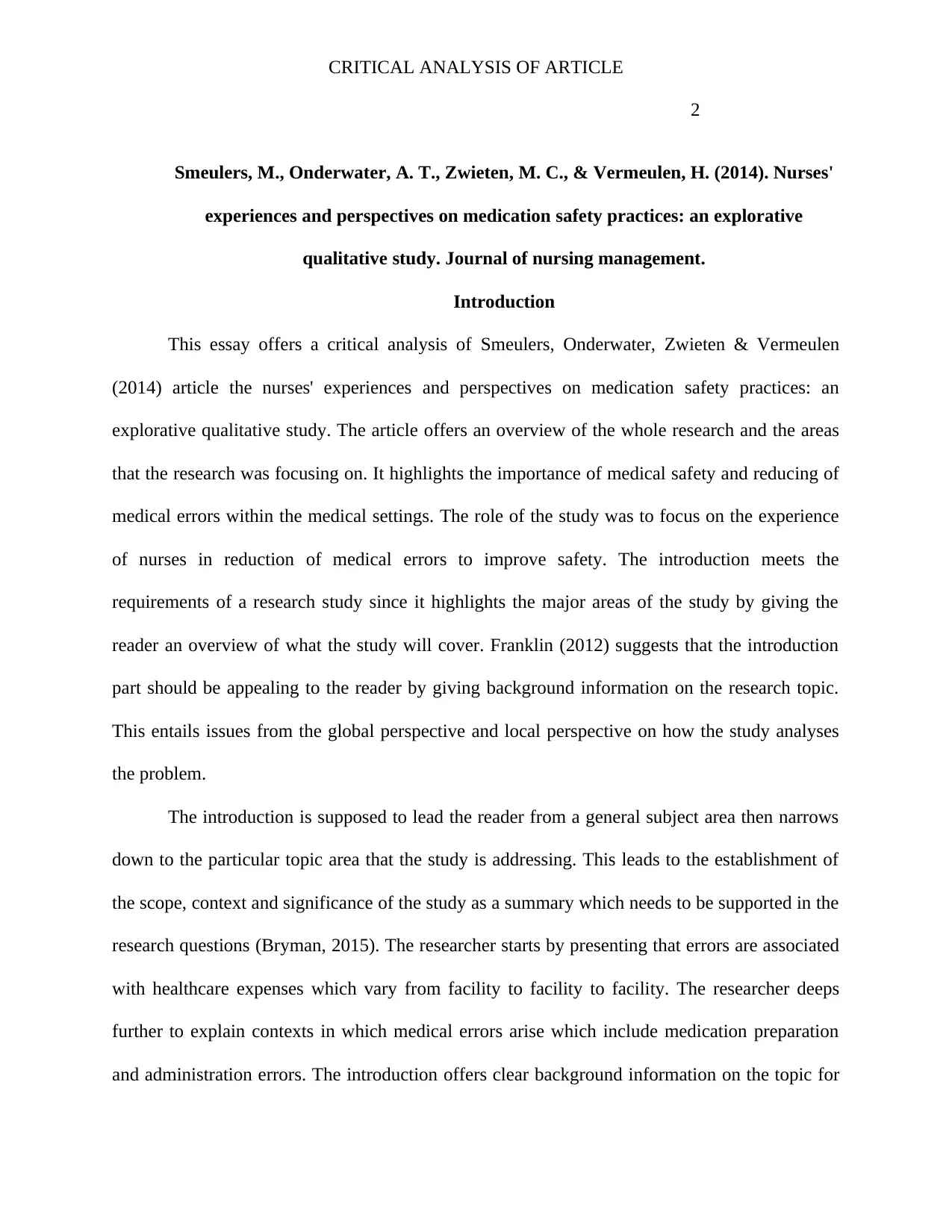
CRITICAL ANALYSIS OF ARTICLE
2
Smeulers, M., Onderwater, A. T., Zwieten, M. C., & Vermeulen, H. (2014). Nurses'
experiences and perspectives on medication safety practices: an explorative
qualitative study. Journal of nursing management.
Introduction
This essay offers a critical analysis of Smeulers, Onderwater, Zwieten & Vermeulen
(2014) article the nurses' experiences and perspectives on medication safety practices: an
explorative qualitative study. The article offers an overview of the whole research and the areas
that the research was focusing on. It highlights the importance of medical safety and reducing of
medical errors within the medical settings. The role of the study was to focus on the experience
of nurses in reduction of medical errors to improve safety. The introduction meets the
requirements of a research study since it highlights the major areas of the study by giving the
reader an overview of what the study will cover. Franklin (2012) suggests that the introduction
part should be appealing to the reader by giving background information on the research topic.
This entails issues from the global perspective and local perspective on how the study analyses
the problem.
The introduction is supposed to lead the reader from a general subject area then narrows
down to the particular topic area that the study is addressing. This leads to the establishment of
the scope, context and significance of the study as a summary which needs to be supported in the
research questions (Bryman, 2015). The researcher starts by presenting that errors are associated
with healthcare expenses which vary from facility to facility to facility. The researcher deeps
further to explain contexts in which medical errors arise which include medication preparation
and administration errors. The introduction offers clear background information on the topic for
2
Smeulers, M., Onderwater, A. T., Zwieten, M. C., & Vermeulen, H. (2014). Nurses'
experiences and perspectives on medication safety practices: an explorative
qualitative study. Journal of nursing management.
Introduction
This essay offers a critical analysis of Smeulers, Onderwater, Zwieten & Vermeulen
(2014) article the nurses' experiences and perspectives on medication safety practices: an
explorative qualitative study. The article offers an overview of the whole research and the areas
that the research was focusing on. It highlights the importance of medical safety and reducing of
medical errors within the medical settings. The role of the study was to focus on the experience
of nurses in reduction of medical errors to improve safety. The introduction meets the
requirements of a research study since it highlights the major areas of the study by giving the
reader an overview of what the study will cover. Franklin (2012) suggests that the introduction
part should be appealing to the reader by giving background information on the research topic.
This entails issues from the global perspective and local perspective on how the study analyses
the problem.
The introduction is supposed to lead the reader from a general subject area then narrows
down to the particular topic area that the study is addressing. This leads to the establishment of
the scope, context and significance of the study as a summary which needs to be supported in the
research questions (Bryman, 2015). The researcher starts by presenting that errors are associated
with healthcare expenses which vary from facility to facility to facility. The researcher deeps
further to explain contexts in which medical errors arise which include medication preparation
and administration errors. The introduction offers clear background information on the topic for
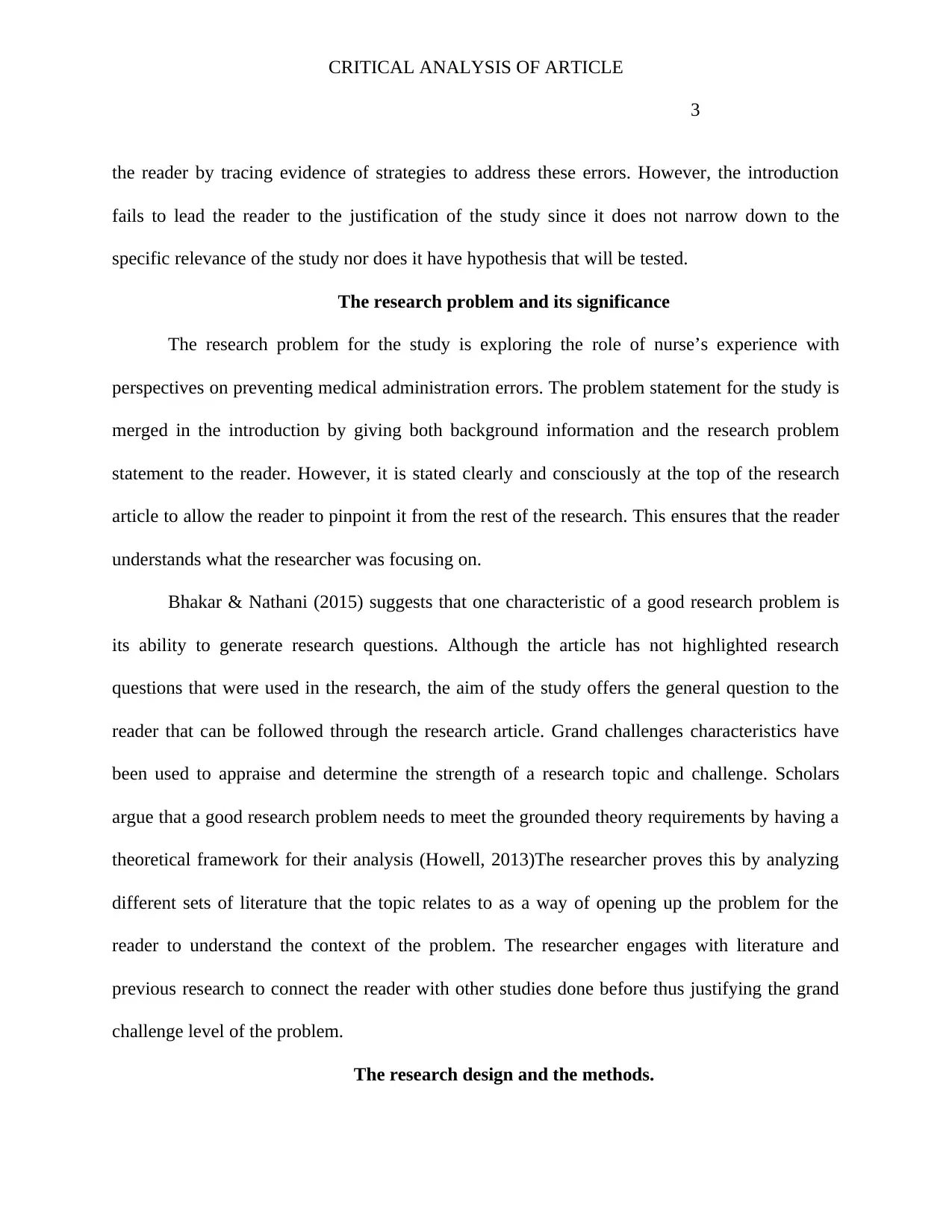
CRITICAL ANALYSIS OF ARTICLE
3
the reader by tracing evidence of strategies to address these errors. However, the introduction
fails to lead the reader to the justification of the study since it does not narrow down to the
specific relevance of the study nor does it have hypothesis that will be tested.
The research problem and its significance
The research problem for the study is exploring the role of nurse’s experience with
perspectives on preventing medical administration errors. The problem statement for the study is
merged in the introduction by giving both background information and the research problem
statement to the reader. However, it is stated clearly and consciously at the top of the research
article to allow the reader to pinpoint it from the rest of the research. This ensures that the reader
understands what the researcher was focusing on.
Bhakar & Nathani (2015) suggests that one characteristic of a good research problem is
its ability to generate research questions. Although the article has not highlighted research
questions that were used in the research, the aim of the study offers the general question to the
reader that can be followed through the research article. Grand challenges characteristics have
been used to appraise and determine the strength of a research topic and challenge. Scholars
argue that a good research problem needs to meet the grounded theory requirements by having a
theoretical framework for their analysis (Howell, 2013)The researcher proves this by analyzing
different sets of literature that the topic relates to as a way of opening up the problem for the
reader to understand the context of the problem. The researcher engages with literature and
previous research to connect the reader with other studies done before thus justifying the grand
challenge level of the problem.
The research design and the methods.
3
the reader by tracing evidence of strategies to address these errors. However, the introduction
fails to lead the reader to the justification of the study since it does not narrow down to the
specific relevance of the study nor does it have hypothesis that will be tested.
The research problem and its significance
The research problem for the study is exploring the role of nurse’s experience with
perspectives on preventing medical administration errors. The problem statement for the study is
merged in the introduction by giving both background information and the research problem
statement to the reader. However, it is stated clearly and consciously at the top of the research
article to allow the reader to pinpoint it from the rest of the research. This ensures that the reader
understands what the researcher was focusing on.
Bhakar & Nathani (2015) suggests that one characteristic of a good research problem is
its ability to generate research questions. Although the article has not highlighted research
questions that were used in the research, the aim of the study offers the general question to the
reader that can be followed through the research article. Grand challenges characteristics have
been used to appraise and determine the strength of a research topic and challenge. Scholars
argue that a good research problem needs to meet the grounded theory requirements by having a
theoretical framework for their analysis (Howell, 2013)The researcher proves this by analyzing
different sets of literature that the topic relates to as a way of opening up the problem for the
reader to understand the context of the problem. The researcher engages with literature and
previous research to connect the reader with other studies done before thus justifying the grand
challenge level of the problem.
The research design and the methods.
⊘ This is a preview!⊘
Do you want full access?
Subscribe today to unlock all pages.

Trusted by 1+ million students worldwide
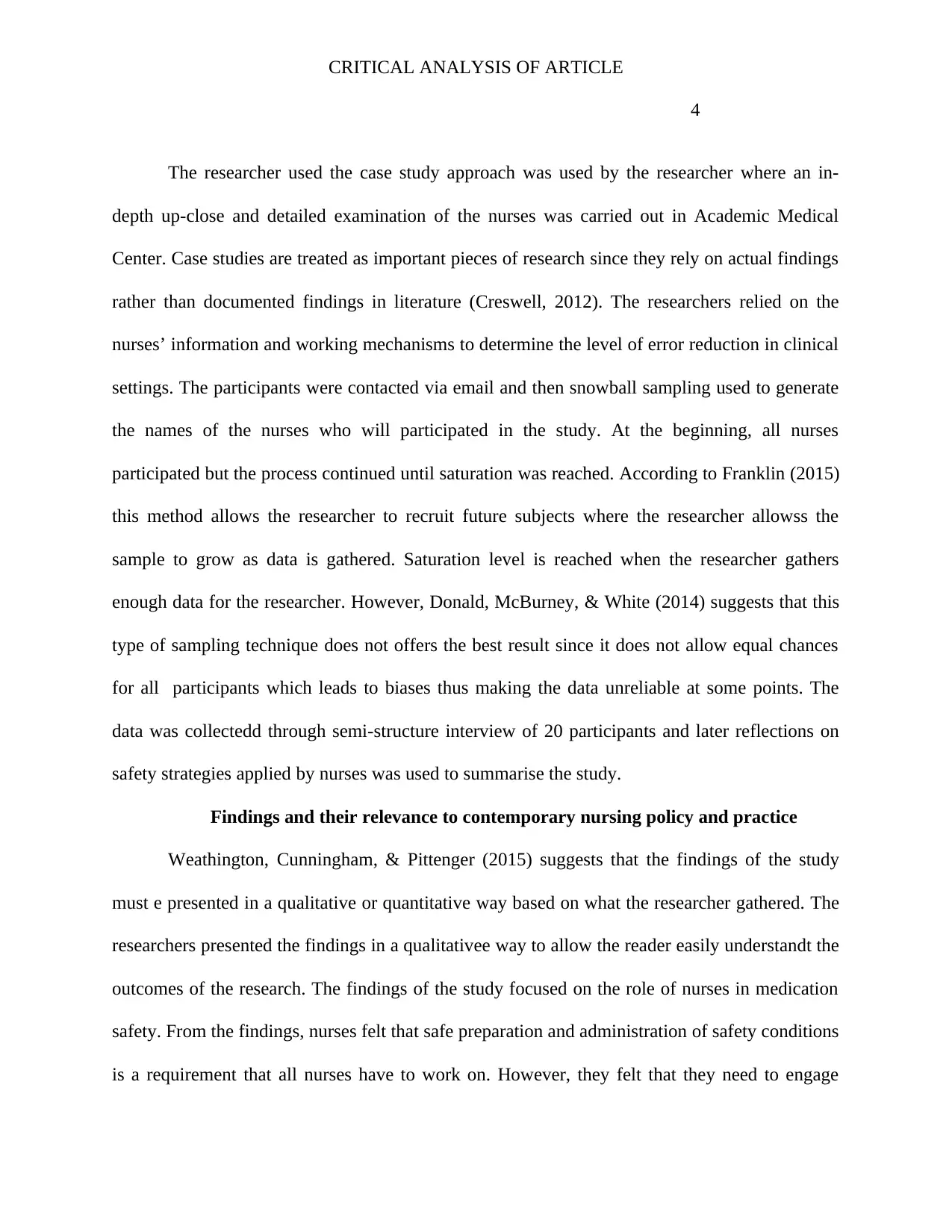
CRITICAL ANALYSIS OF ARTICLE
4
The researcher used the case study approach was used by the researcher where an in-
depth up-close and detailed examination of the nurses was carried out in Academic Medical
Center. Case studies are treated as important pieces of research since they rely on actual findings
rather than documented findings in literature (Creswell, 2012). The researchers relied on the
nurses’ information and working mechanisms to determine the level of error reduction in clinical
settings. The participants were contacted via email and then snowball sampling used to generate
the names of the nurses who will participated in the study. At the beginning, all nurses
participated but the process continued until saturation was reached. According to Franklin (2015)
this method allows the researcher to recruit future subjects where the researcher allowss the
sample to grow as data is gathered. Saturation level is reached when the researcher gathers
enough data for the researcher. However, Donald, McBurney, & White (2014) suggests that this
type of sampling technique does not offers the best result since it does not allow equal chances
for all participants which leads to biases thus making the data unreliable at some points. The
data was collectedd through semi-structure interview of 20 participants and later reflections on
safety strategies applied by nurses was used to summarise the study.
Findings and their relevance to contemporary nursing policy and practice
Weathington, Cunningham, & Pittenger (2015) suggests that the findings of the study
must e presented in a qualitative or quantitative way based on what the researcher gathered. The
researchers presented the findings in a qualitativee way to allow the reader easily understandt the
outcomes of the research. The findings of the study focused on the role of nurses in medication
safety. From the findings, nurses felt that safe preparation and administration of safety conditions
is a requirement that all nurses have to work on. However, they felt that they need to engage
4
The researcher used the case study approach was used by the researcher where an in-
depth up-close and detailed examination of the nurses was carried out in Academic Medical
Center. Case studies are treated as important pieces of research since they rely on actual findings
rather than documented findings in literature (Creswell, 2012). The researchers relied on the
nurses’ information and working mechanisms to determine the level of error reduction in clinical
settings. The participants were contacted via email and then snowball sampling used to generate
the names of the nurses who will participated in the study. At the beginning, all nurses
participated but the process continued until saturation was reached. According to Franklin (2015)
this method allows the researcher to recruit future subjects where the researcher allowss the
sample to grow as data is gathered. Saturation level is reached when the researcher gathers
enough data for the researcher. However, Donald, McBurney, & White (2014) suggests that this
type of sampling technique does not offers the best result since it does not allow equal chances
for all participants which leads to biases thus making the data unreliable at some points. The
data was collectedd through semi-structure interview of 20 participants and later reflections on
safety strategies applied by nurses was used to summarise the study.
Findings and their relevance to contemporary nursing policy and practice
Weathington, Cunningham, & Pittenger (2015) suggests that the findings of the study
must e presented in a qualitative or quantitative way based on what the researcher gathered. The
researchers presented the findings in a qualitativee way to allow the reader easily understandt the
outcomes of the research. The findings of the study focused on the role of nurses in medication
safety. From the findings, nurses felt that safe preparation and administration of safety conditions
is a requirement that all nurses have to work on. However, they felt that they need to engage
Paraphrase This Document
Need a fresh take? Get an instant paraphrase of this document with our AI Paraphraser
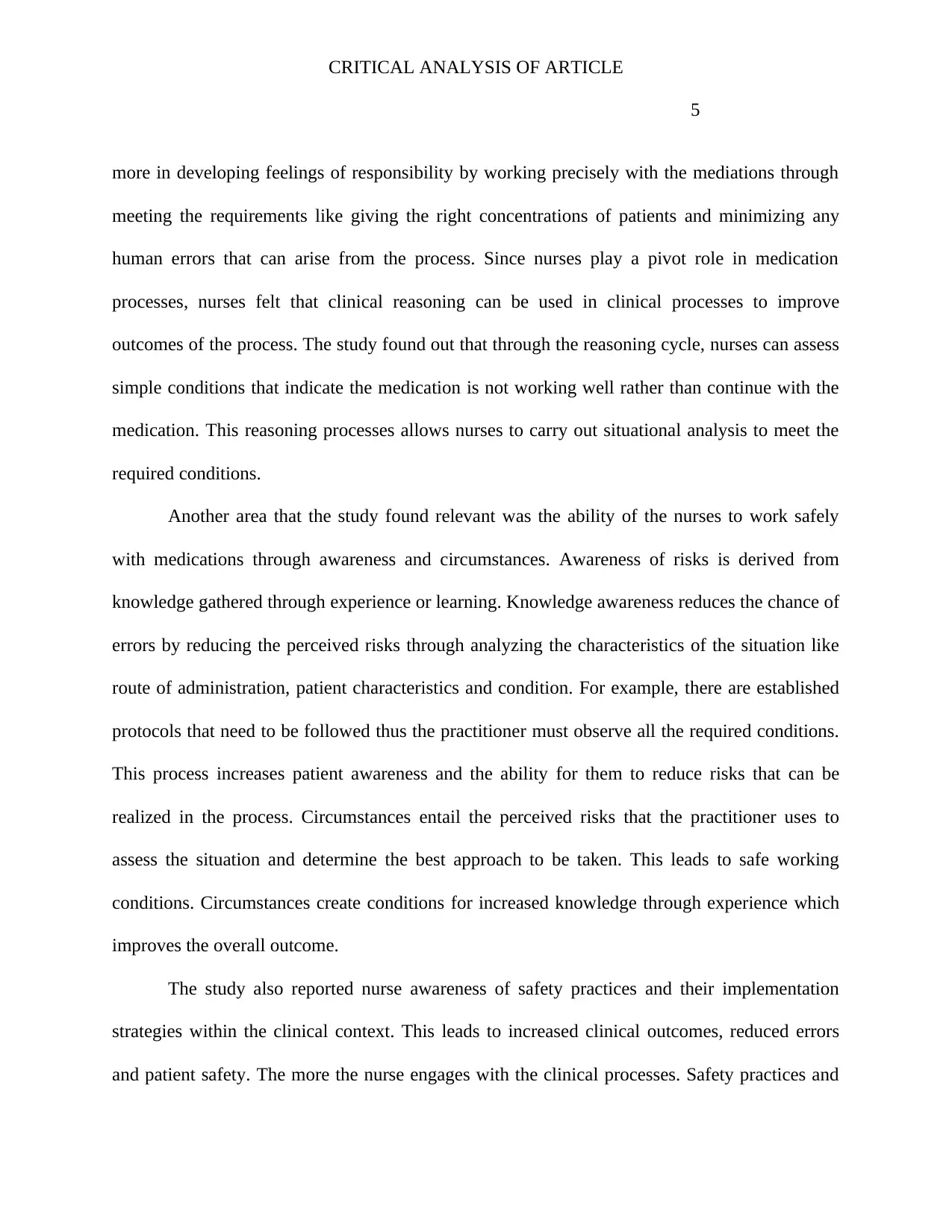
CRITICAL ANALYSIS OF ARTICLE
5
more in developing feelings of responsibility by working precisely with the mediations through
meeting the requirements like giving the right concentrations of patients and minimizing any
human errors that can arise from the process. Since nurses play a pivot role in medication
processes, nurses felt that clinical reasoning can be used in clinical processes to improve
outcomes of the process. The study found out that through the reasoning cycle, nurses can assess
simple conditions that indicate the medication is not working well rather than continue with the
medication. This reasoning processes allows nurses to carry out situational analysis to meet the
required conditions.
Another area that the study found relevant was the ability of the nurses to work safely
with medications through awareness and circumstances. Awareness of risks is derived from
knowledge gathered through experience or learning. Knowledge awareness reduces the chance of
errors by reducing the perceived risks through analyzing the characteristics of the situation like
route of administration, patient characteristics and condition. For example, there are established
protocols that need to be followed thus the practitioner must observe all the required conditions.
This process increases patient awareness and the ability for them to reduce risks that can be
realized in the process. Circumstances entail the perceived risks that the practitioner uses to
assess the situation and determine the best approach to be taken. This leads to safe working
conditions. Circumstances create conditions for increased knowledge through experience which
improves the overall outcome.
The study also reported nurse awareness of safety practices and their implementation
strategies within the clinical context. This leads to increased clinical outcomes, reduced errors
and patient safety. The more the nurse engages with the clinical processes. Safety practices and
5
more in developing feelings of responsibility by working precisely with the mediations through
meeting the requirements like giving the right concentrations of patients and minimizing any
human errors that can arise from the process. Since nurses play a pivot role in medication
processes, nurses felt that clinical reasoning can be used in clinical processes to improve
outcomes of the process. The study found out that through the reasoning cycle, nurses can assess
simple conditions that indicate the medication is not working well rather than continue with the
medication. This reasoning processes allows nurses to carry out situational analysis to meet the
required conditions.
Another area that the study found relevant was the ability of the nurses to work safely
with medications through awareness and circumstances. Awareness of risks is derived from
knowledge gathered through experience or learning. Knowledge awareness reduces the chance of
errors by reducing the perceived risks through analyzing the characteristics of the situation like
route of administration, patient characteristics and condition. For example, there are established
protocols that need to be followed thus the practitioner must observe all the required conditions.
This process increases patient awareness and the ability for them to reduce risks that can be
realized in the process. Circumstances entail the perceived risks that the practitioner uses to
assess the situation and determine the best approach to be taken. This leads to safe working
conditions. Circumstances create conditions for increased knowledge through experience which
improves the overall outcome.
The study also reported nurse awareness of safety practices and their implementation
strategies within the clinical context. This leads to increased clinical outcomes, reduced errors
and patient safety. The more the nurse engages with the clinical processes. Safety practices and
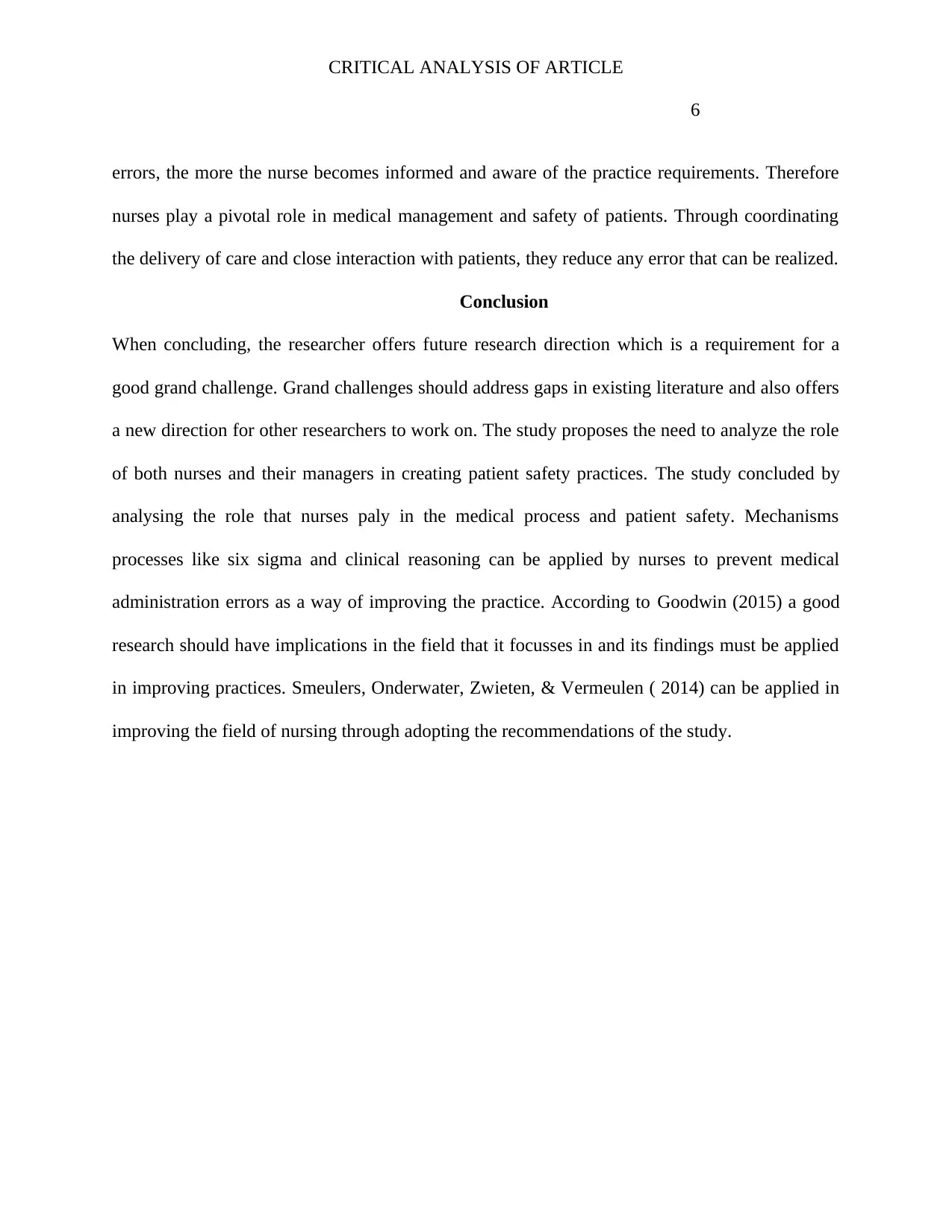
CRITICAL ANALYSIS OF ARTICLE
6
errors, the more the nurse becomes informed and aware of the practice requirements. Therefore
nurses play a pivotal role in medical management and safety of patients. Through coordinating
the delivery of care and close interaction with patients, they reduce any error that can be realized.
Conclusion
When concluding, the researcher offers future research direction which is a requirement for a
good grand challenge. Grand challenges should address gaps in existing literature and also offers
a new direction for other researchers to work on. The study proposes the need to analyze the role
of both nurses and their managers in creating patient safety practices. The study concluded by
analysing the role that nurses paly in the medical process and patient safety. Mechanisms
processes like six sigma and clinical reasoning can be applied by nurses to prevent medical
administration errors as a way of improving the practice. According to Goodwin (2015) a good
research should have implications in the field that it focusses in and its findings must be applied
in improving practices. Smeulers, Onderwater, Zwieten, & Vermeulen ( 2014) can be applied in
improving the field of nursing through adopting the recommendations of the study.
6
errors, the more the nurse becomes informed and aware of the practice requirements. Therefore
nurses play a pivotal role in medical management and safety of patients. Through coordinating
the delivery of care and close interaction with patients, they reduce any error that can be realized.
Conclusion
When concluding, the researcher offers future research direction which is a requirement for a
good grand challenge. Grand challenges should address gaps in existing literature and also offers
a new direction for other researchers to work on. The study proposes the need to analyze the role
of both nurses and their managers in creating patient safety practices. The study concluded by
analysing the role that nurses paly in the medical process and patient safety. Mechanisms
processes like six sigma and clinical reasoning can be applied by nurses to prevent medical
administration errors as a way of improving the practice. According to Goodwin (2015) a good
research should have implications in the field that it focusses in and its findings must be applied
in improving practices. Smeulers, Onderwater, Zwieten, & Vermeulen ( 2014) can be applied in
improving the field of nursing through adopting the recommendations of the study.
⊘ This is a preview!⊘
Do you want full access?
Subscribe today to unlock all pages.

Trusted by 1+ million students worldwide
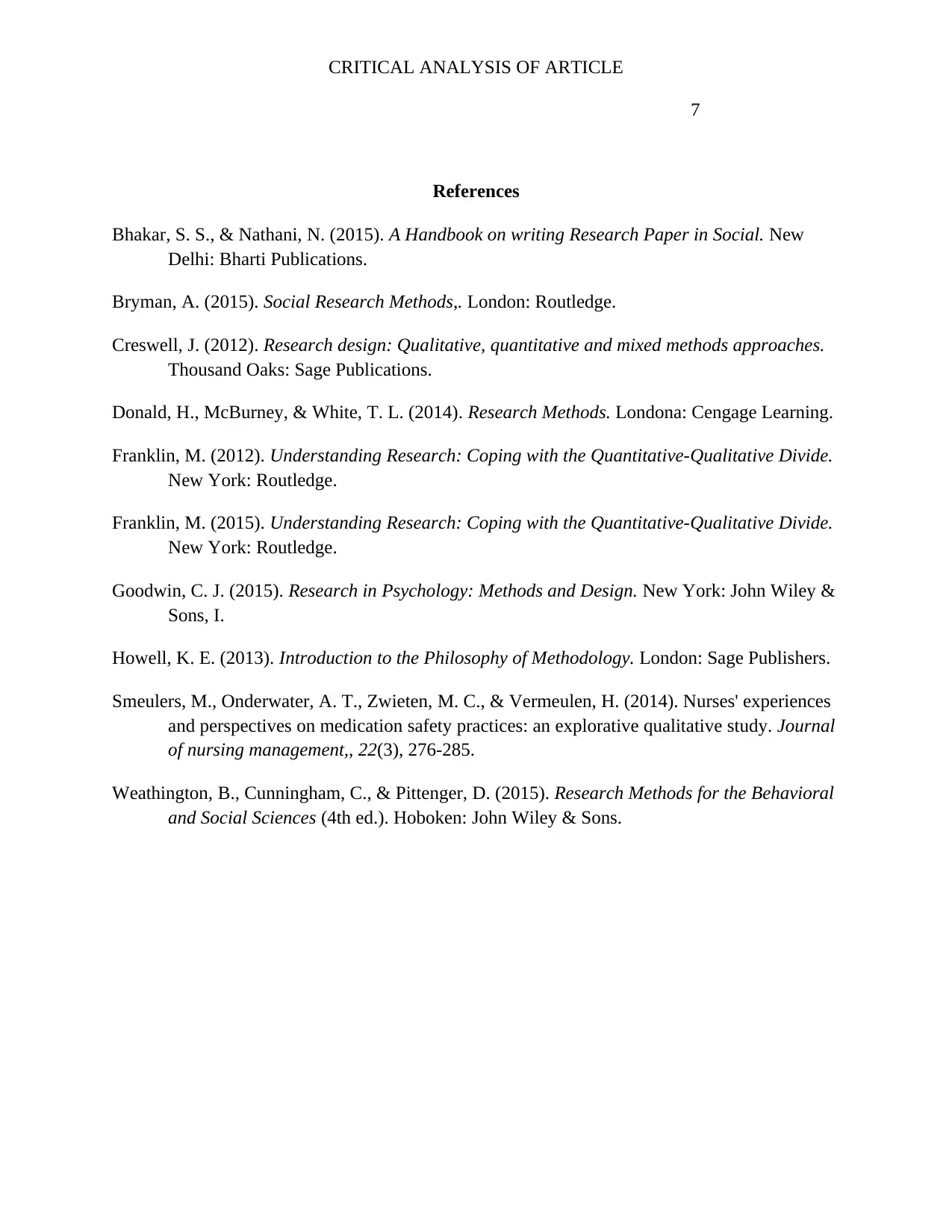
CRITICAL ANALYSIS OF ARTICLE
7
References
Bhakar, S. S., & Nathani, N. (2015). A Handbook on writing Research Paper in Social. New
Delhi: Bharti Publications.
Bryman, A. (2015). Social Research Methods,. London: Routledge.
Creswell, J. (2012). Research design: Qualitative, quantitative and mixed methods approaches.
Thousand Oaks: Sage Publications.
Donald, H., McBurney, & White, T. L. (2014). Research Methods. Londona: Cengage Learning.
Franklin, M. (2012). Understanding Research: Coping with the Quantitative-Qualitative Divide.
New York: Routledge.
Franklin, M. (2015). Understanding Research: Coping with the Quantitative-Qualitative Divide.
New York: Routledge.
Goodwin, C. J. (2015). Research in Psychology: Methods and Design. New York: John Wiley &
Sons, I.
Howell, K. E. (2013). Introduction to the Philosophy of Methodology. London: Sage Publishers.
Smeulers, M., Onderwater, A. T., Zwieten, M. C., & Vermeulen, H. (2014). Nurses' experiences
and perspectives on medication safety practices: an explorative qualitative study. Journal
of nursing management,, 22(3), 276-285.
Weathington, B., Cunningham, C., & Pittenger, D. (2015). Research Methods for the Behavioral
and Social Sciences (4th ed.). Hoboken: John Wiley & Sons.
7
References
Bhakar, S. S., & Nathani, N. (2015). A Handbook on writing Research Paper in Social. New
Delhi: Bharti Publications.
Bryman, A. (2015). Social Research Methods,. London: Routledge.
Creswell, J. (2012). Research design: Qualitative, quantitative and mixed methods approaches.
Thousand Oaks: Sage Publications.
Donald, H., McBurney, & White, T. L. (2014). Research Methods. Londona: Cengage Learning.
Franklin, M. (2012). Understanding Research: Coping with the Quantitative-Qualitative Divide.
New York: Routledge.
Franklin, M. (2015). Understanding Research: Coping with the Quantitative-Qualitative Divide.
New York: Routledge.
Goodwin, C. J. (2015). Research in Psychology: Methods and Design. New York: John Wiley &
Sons, I.
Howell, K. E. (2013). Introduction to the Philosophy of Methodology. London: Sage Publishers.
Smeulers, M., Onderwater, A. T., Zwieten, M. C., & Vermeulen, H. (2014). Nurses' experiences
and perspectives on medication safety practices: an explorative qualitative study. Journal
of nursing management,, 22(3), 276-285.
Weathington, B., Cunningham, C., & Pittenger, D. (2015). Research Methods for the Behavioral
and Social Sciences (4th ed.). Hoboken: John Wiley & Sons.
1 out of 7
Related Documents
Your All-in-One AI-Powered Toolkit for Academic Success.
+13062052269
info@desklib.com
Available 24*7 on WhatsApp / Email
![[object Object]](/_next/static/media/star-bottom.7253800d.svg)
Unlock your academic potential
Copyright © 2020–2025 A2Z Services. All Rights Reserved. Developed and managed by ZUCOL.



